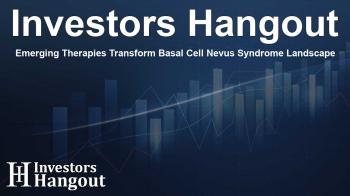Emerging Therapies Transform Basal Cell Nevus Syndrome Landscape

Exploring the Basal Cell Nevus Syndrome Market Growth
The basal cell nevus syndrome (BCNS) market is on track for significant growth, spurred by increased awareness, advancements in targeted therapies, and the development of innovative hedgehog pathway inhibitors. Companies like Ono Pharmaceuticals and Bristol Myers Squibb are at the forefront with their promising new treatments geared toward addressing the complexities of BCNS, which affects thousands of individuals globally.
Market Overview and Projections
As the market for basal cell nevus syndrome evolves, the anticipated launch of therapies such as ONO-4538, ONC206, SGT-610, and SUBA-Itraconazole could drive substantial changes in treatment approaches. Over the next decade, these emerging drugs are expected to redefine the standards of care within BCNS, improving lives and offering new hope to patients battling this challenging genetic disorder.
Factors Influencing Market Expansion
Several factors are fueling the growth of the basal cell nevus syndrome market:
Increased Prevalence and Awareness of BCNS
BCNS, commonly referred to as Gorlin Syndrome, is a rare genetic disorder characterized by multiple basal cell carcinomas and other health issues. Its prevalence in Europe is estimated at between 1 in 31,000 and 1 in 164,000, while the birth prevalence in the UK is about 1 in 19,000. The growing recognition of the condition among healthcare providers and the public is leading to improved diagnosis rates, which in turn drives demand for specialized treatments.
Advancements in Genetic Research
The exploration of the genetic bases of BCNS is paving the way for groundbreaking therapies. Innovative approaches like gene editing and personalized medicine are offering fresh perspectives, enabling tailored interventions that address the underlying mechanisms of the syndrome.
Analysis of Current Treatments
The treatment landscape for Gorlin syndrome often relies on off-label usage of Hedgehog pathway inhibitors, including vismodegib and sonidegib, traditionally associated with advanced basal cell carcinoma. Current care typically includes the surgical removal of tumors and supportive treatments, although systemic therapies are increasingly considered for inoperable cases. Nonetheless, there exists a pressing need for safer and more effective treatments due to the complications associated with long-term use of existing therapies.
Emerging Therapies Show Promise
Exciting developments are on the horizon. For instance, SGT-610 (Patidegib Gel 2%) is being investigated for its potential to minimize systemic exposure while efficiently targeting tumors. Another innovative therapy, SUBA-Itraconazole, showcases an enhanced formulation aimed at improving bioavailability and therapeutic outcomes for BCNS patients.
Competitive Landscape
The competitive dynamics in the BCNS market are influenced by key players, including Ono Pharmaceuticals, Bristol Myers Squibb, Jazz Pharmaceuticals, and Inhibitor Therapeutics, among others. The expected approval of therapies like SGT-610, which blocks SMO signaling to inhibit tumor growth, could signal a transformation in treatment paradigms. Currently, there is anticipation surrounding the Phase III trial results for SGT-610, which are expected soon.
Innovative Approaches to Treatment
Inhibitor Therapeutics is also making strides with SUBA-Itraconazole, which is currently undergoing clinical trials for the treatment of basal cell carcinomas in BCNS patients. These two emerging therapies exemplify the industry's effort to develop more effective treatment modalities that could enhance patient outcomes and reshape the BCNS market's future.
Conclusion and Future Perspectives
The landscape for basal cell nevus syndrome is ripe for change, with various innovative therapies in the pipeline anticipated to expand treatment options. As these new therapies gain momentum and pass through regulatory frameworks, there is potential for a significant shift in how BCNS is managed, ultimately improving the quality of life for those affected.
Frequently Asked Questions
What is Basal Cell Nevus Syndrome?
Basal cell nevus syndrome (BCNS) is a genetic disorder characterized by the development of multiple basal cell carcinomas and various systemic abnormalities.
How common is BCNS?
The estimated prevalence of BCNS varies and ranges from 1 in 31,000 to 1 in 164,000 in Europe, highlighting its rarity.
What are the current treatment options for BCNS?
Current treatment mainly includes surgical intervention and off-label therapies such as Hedgehog pathway inhibitors used in other contexts, alongside ongoing clinical trials for newer drugs.
What advancements are being made in BCNS therapies?
Innovative treatments such as SGT-610 and SUBA-Itraconazole target the disease more effectively while aiming to reduce adverse effects traditionally associated with existing treatments.
What is the future outlook for BCNS management?
With the development of several promising therapies, the future of BCNS management appears optimistic, with improved options likely to transform patient care significantly.
About The Author
Contact Kelly Martin privately here. Or send an email with ATTN: Kelly Martin as the subject to contact@investorshangout.com.
About Investors Hangout
Investors Hangout is a leading online stock forum for financial discussion and learning, offering a wide range of free tools and resources. It draws in traders of all levels, who exchange market knowledge, investigate trading tactics, and keep an eye on industry developments in real time. Featuring financial articles, stock message boards, quotes, charts, company profiles, and live news updates. Through cooperative learning and a wealth of informational resources, it helps users from novices creating their first portfolios to experts honing their techniques. Join Investors Hangout today: https://investorshangout.com/
The content of this article is based on factual, publicly available information and does not represent legal, financial, or investment advice. Investors Hangout does not offer financial advice, and the author is not a licensed financial advisor. Consult a qualified advisor before making any financial or investment decisions based on this article. This article should not be considered advice to purchase, sell, or hold any securities or other investments. If any of the material provided here is inaccurate, please contact us for corrections.

